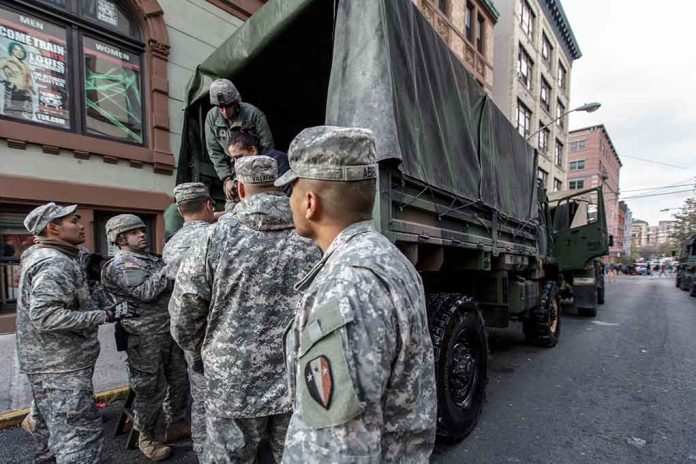
U.S. military receives unprecedented authority to detain migrants along a newly designated defense zone in New Mexico, marking a significant shift in border security operations.
Key Takeaways
- The U.S. Army has been granted expanded authority to detain illegal immigrants in parts of New Mexico along the southern border.
- A 60-foot-wide strip of land along the New Mexico-Mexico border has been designated as part of Arizona’s Fort Huachuca, creating a “National Defense Area.”
- U.S. Northern Command can now search, detain, and provide medical assistance to migrants before transferring them to Customs and Border Protection.
- The Department of the Interior transferred nearly 110,000 acres of federal land to the Army for border security operations for a three-year period.
- This initiative is part of President Trump’s broader strategy to utilize military forces on public land across three border states.
Military’s New Border Security Role Defined
In a significant development for U.S. border security, the U.S. Northern Command has received expanded powers to detain migrants within a newly designated zone in New Mexico. This 60-foot-wide strip of land along the U.S.-Mexico border has been classified as part of Arizona’s Fort Huachuca, effectively creating a military-controlled “National Defense Area.” The designation transforms what was previously Department of Interior land into a zone where military personnel can take direct action against unauthorized border crossings, representing an unprecedented expansion of military involvement in immigration enforcement.
The enhanced authorities permit U.S. Northern Command to search, detain, provide medical assistance, and implement crowd control measures for illegal trespassers in this zone. After initial detention, migrants will be handed over to Customs and Border Protection or other law enforcement agencies. This arrangement creates a new layer of border enforcement before migrants can reach civilian law enforcement, optimizing available resources and addressing the ongoing challenges at the southern border.
🚨 BREAKING: TRUMP JUST TURNED THE BORDER INTO A MILITARY ZONE 🚨
The game has changed.
President Trump has just authorized the U.S. MILITARY to take control of federal land along the southern border.
→ 60 feet wide.
→ Stretching across California, Arizona & New Mexico.
→… pic.twitter.com/DJt2IsVvUh— Jim Ferguson (@JimFergusonUK) April 12, 2025
Operational Structure and Implementation
Joint Task Force-Southern Border will spearhead the military’s enhanced border security operations with a comprehensive approach including vehicle and foot patrols, rotary wing operations, and fixed surveillance site monitoring. Army troops will work alongside U.S. Customs and Border Protection to patrol and prevent illegal activities at the border. The task force has additional responsibilities including setting up temporary barriers, signage, and fencing to clearly demarcate the military-controlled area and deter unauthorized crossings.
“Through these enhanced authorities, U.S. Northern Command will ensure those who illegally trespass in the New Mexico National Defense Area are handed over to Customs and Border Protection or our other law enforcement partners. Joint Task Force-Southern Border will conduct enhanced detection and monitoring, which will include vehicle and foot patrols, rotary wing, and fixed surveillance site operations,” said Gen. Gregory Guillot, USNORTHCOM commander.
The initiative covers the Roosevelt Reservation, a federally controlled strip of land that borders Mexico across parts of Arizona and New Mexico. The Department of the Interior has transferred approximately 110,000 acres of federal land to the Army to support these border security operations for a three-year period. This substantial land transfer provides the physical space needed for the military to establish a meaningful presence and conduct effective operations along a significant portion of the southern border.
Expansion Plans and Strategic Implications
The administration has indicated that this initiative will expand beyond New Mexico in the coming weeks. White House Press Secretary Karoline Leavitt announced that the current national defense area spans more than 170 miles across the border in New Mexico, with plans to add more than 90 miles in Texas. This phased approach suggests a carefully coordinated strategy to progressively strengthen border security along the most critical sections of the U.S.-Mexico border.
This development represents a significant shift in military involvement in civilian affairs, which has traditionally been limited to prevent the militarization of domestic policing. The initiative was set in motion on April 11 when President Trump transferred control of the Roosevelt Reservation area from the Department of the Interior to the Department of Defense. General Gregory Guillot, commander of U.S. Northern Command, is now responsible for implementing the executive orders on illegal immigration at the southern border within this newly designated military zone.









